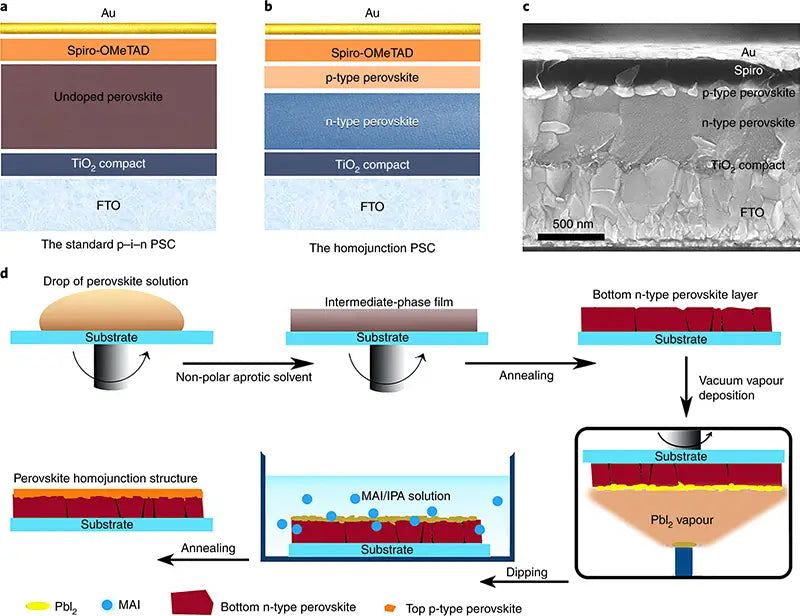
As mentioned above, a solar battery is a device that uses the photovoltaic effect to convert light energy into electrical energy, also known as a photovoltaic device. The phenomenon that substances absorb light energy to generate electromotive force is called photovoltaic effect. This phenomenon occurs in both liquid and solid substances. However, only in solids, especially in semiconductors, is there a high energy conversion efficiency. So people often refer to solar battery as semiconductor solar battery.
The main feature of a solar battery semiconductor is not only that its resistivity is numerically different from that of conductors and insulators, but also that its electrical conductivity has the following two remarkable characteristics:
(1) The change of the resistivity of the solar battery semiconductor is greatly affected by the impurity content. For example, as long as silicon contains 1 part in 100 million boron, the resistivity will drop to 1% of the original. If the type of impurities contained is different, the conductivity type is also different
(2) The resistivity of solar battery semiconductors is greatly affected by external conditions such as light and heat. The resistivity of solar battery semiconductors decreases rapidly when the temperature increases or when exposed to light. For some special solar battery semiconductors, the resistivity will also change under the action of electric and magnetic fields.

There are many types of solar battery semiconductor materials. According to their chemical composition, they can be divided into elemental semiconductors and compound semiconductors; according to whether they contain impurities, they can be divided into intrinsic semiconductors and impurity semiconductors; according to their conductivity types, they can be divided into N-type semiconductors and P-type semiconductors; in addition, according to the physical properties of solar battery semiconductors, they can also be divided into magnetic semiconductors, piezoelectric semiconductors, ferroelectric semiconductors, organic semiconductors, glass semiconductors, gas-sensitive semiconductors, etc. At present, the widely used semiconductor materials for solar battery include germanium, silicon, selenium, gallium arsenide, gallium phosphide, indium antimonide, etc. Among them, germanium and silicon materials are the most mature and widely used semiconductor materials for solar battery. Manufactured, it has developed into a wide variety and in various forms.
1. Solar battery is classified by structure
According to different structures, solar battery can be divided into the following three categories:
(1) Homojunction solar battery. Homojunction solar battery is solar battery with one or more PN junctions composed of the same semiconductor material, such as silicon solar battery, gallium arsenide solar battery, etc.

(2) Heterojunction solar battery. Heterojunction solar battery is solar battery that use two semiconductor materials with different band gaps to form a hetero PN junction at the interface, such as indium tin oxide/silicon solar battery, cuprous sulfide/tin sulfide solar battery, etc. . If the lattice structures of the two heterogeneous materials are similar and the lattice matching at the interface is good, it is called a heterojunction solar battery, such as AlGaAs/GaAs heteroplane solar battery.
(3) Schottky junction solar battery. Schottky junction solar battery is solar battery that use metal and semiconductor contacts to form a "Schottky barrier", also known as MS solar battery. The principle is based on the Schottky effect that metal-semiconductor contacts can produce rectifier contacts under certain conditions. At present, solar battery with this structure have been developed into metal monoxide-semiconductor solar battery, namely MOS solar battery, such as platinum/silicon Schottky junction solar battery, aluminum/silicon Schottky junction solar battery, and the like.
2. Solar battery is classified by material
According to different materials, solar battery can be divided into the following three categories:
(1) Silicon solar battery. This kind of solar battery is a solar battery with silicon as the base material, such as single-product silicon solar battery, polycrystalline silicon solar battery, amorphous silicon solar battery and the like. The material for making multi-product silicon solar battery can be made of solar-grade silicon that is not too pure. And solar grade silicon can be processed from metallurgical grade silicon with a simple process. Polysilicon materials include ribbon silicon, cast silicon, and thin-film polysilicon. Solar battery made with them is available in thin films and sheets.
(2) Cadmium sulfide solar battery. This kind of solar battery is a solar battery with cadmium sulfide single crystal or polycrystal as the matrix material, such as cuprous sulfide/cadmium sulfide solar battery, cadmium telluride/cadmium sulfide solar battery, copper indium selenide/cadmium sulfide solar battery and the like.
(3) GaAs solar battery. This solar battery is a solar battery with gallium arsenide as the base material, such as a homojunction gallium arsenide solar battery, a heterojunction gallium arsenide solar battery, and the like.
Classification according to the structure of solar battery, its physical meaning is relatively clear, so it has been adopted by the country as the basis for the naming method of solar battery.
Read more: China's abundant solar energy resources
















